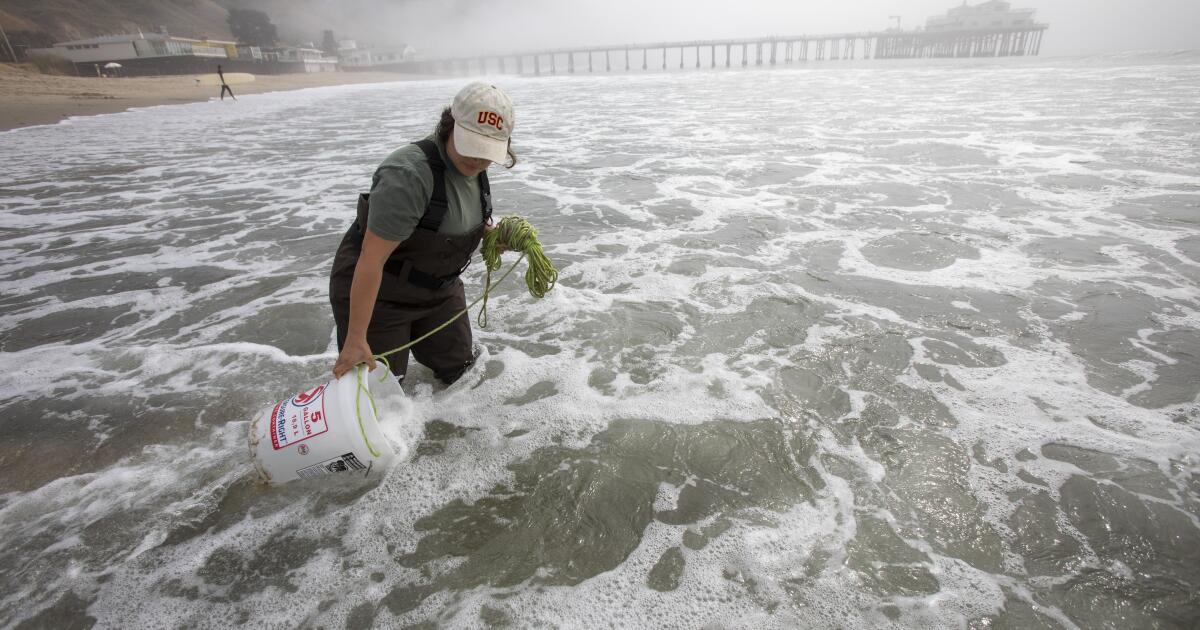
When scores of dead and dying sea animals began washing up on L.A.-area beaches just weeks after January’s devastating fires, the timing seemed suspicious.
Harmful algae blooms had sickened marine life in each of the three years prior. But the especially high number of animal deaths this year prompted several research teams to investigate whether runoff from the fires may have accelerated algae growth to particularly dangerous proportions.
The evidence available so far suggests that this year’s algae bloom would have been just as deadly if the catastrophe on land hadn’t happened, multiple scientists said this week.
“Some of the fire retardants have nutrients in them, like ammonia or phosphate, that can fuel the growth of phytoplankton and the growth of organisms in the ocean. And we do see some spikes in those nutrients early on, immediately post-fire,” said Noelle Held, a University of Southern California microbiologist and oceanographer who has tested ocean water along L.A.’s coastline regularly since January. “But those increases are completely dwarfed by the major shift that happened in the ocean between the end of February and the beginning of April — the upwelling event.”
Upwellings occur when winds push warmer surface waters from the coastline out to sea, allowing colder, nutrient-rich waters from deeper in the ocean to rise up and take their place. These surges occur naturally in Southern California in winter and spring and contain elements like nitrogen and phosphorus that feed microbes (algae included). They often precede harmful algae blooms, though scientists are still trying to figure out the precise balance of factors that lead to sudden explosions in toxin-producing algae species.
Four different algae species were present in this year’s bloom. The two most dangerous produce powerful neurotoxins that accumulate in the marine food chain: Alexandrium catenella, which produces saxitoxin, and Pseudo-nitzschia australis, which produces domoic acid.
The toxins accumulate in filter-feeding fish, and then poison the larger mammals who eat them.
Scientists have known from the beginning that the fires didn’t initiate this year’s bloom. This is the fourth harmful algae bloom in as many years, and levels of toxin-producing species were rising before the Palisades and Eaton fires began. But the acceleration of marine wildlife deaths in the weeks after the fires led some to wonder whether L.A.’s disaster on land was also worsening the crisis in the sea.
However, based on the data available, fire pollution appears to have influenced the ocean’s chemistry far less than this year’s upwelling effect did.
“The only thing we could say is that [the fires] added some nutrients to an already nutrient-rich environment,” said Dave Bader, a marine biologist and the chief operations and education officer for the Marine Mammal Care Center in San Pedro. Runoff from the fires added fewer nutrients over the course of the bloom than sewage treatment facilities did, he said.
Beginning in February, hundreds of dolphins and sea lions started washing up on California beaches, either dead or suffering from neurotoxin poisoning symptoms such as aggression, lethargy and seizures. A minke whale in Long Beach Harbor and a gray whale stranded on Huntington City Beach also succumbed to the outbreak. Scientists believe countless more animals died at sea before the outbreak abated in May.
The year’s bloom was the deadliest for marine mammals since a 2015-16 outbreak that killed thousands along the Pacific coast between Alaska and Baja California.
Similarly, this year’s outbreak stretched from Baja California in Mexico to Bodega Bay in Northern California. The sheer geographic extent of the damage suggests that L.A.’s fires played a minimal role, said Clarissa Anderson of UC San Diego’s Scripps Institution of Oceanography. She directs the Southern California Coastal Ocean Observing System, or SCCOOS, which monitors algae blooms.
The only sign that L.A.’s waters could be unhealthier than other coastal stretches this year was an unusually high spike of Pseudo-nitzschia in March at the Santa Monica Pier, Anderson said. But even that wasn’t significantly higher than readings elsewhere along the coast.



